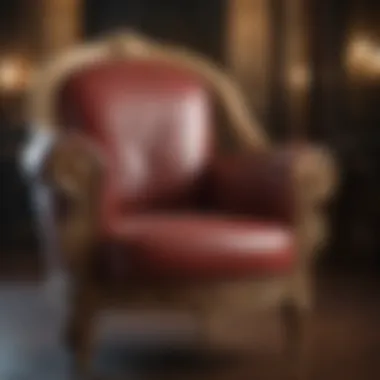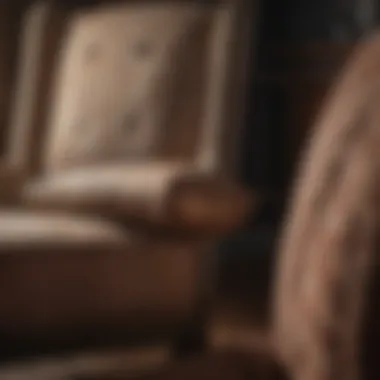Luxury Vintage Furniture: Historical Elegance and Craftsmanship


Intro
Luxury vintage furniture holds a timeless appeal that captivates enthusiasts and collectors alike. This fascination goes beyond mere aesthetics; there’s a profound narrative woven into each piece. The history, craftsmanship, and design philosophies behind vintage furniture not only illuminate past eras but also influence contemporary styles. As individuals seek to infuse their spaces with character and legacy, understanding the intricacies of luxury vintage furniture becomes essential.
This exploration invites you to delve deep into the defining traits of vintage pieces, examining how they effortlessly blend history with modern aesthetics. From practical restoration tips to sourcing unique items, this guide lays the foundation for curating an extraordinary living environment that reflects a sophisticated taste and appreciation for the richness of history.
Prolusion to Luxury Vintage Furniture
In recent times, vintage furniture has drawn increasing attention for its unique charm, historical significance, and unparalleled craftsmanship. Luxury vintage furniture stands out as a hallmark of elegance and sophistication. This article explores the many facets that contribute to the richness of this topic, illuminating its importance not just as collectibles but as integral elements in design and décor.
The Allure of the Past
There’s an innate fascination with the past, and it seeps into all areas of life, especially in design. Vintage furniture has a story to tell. When you gaze upon a beautifully aged Edwardian sofa or an Art Deco side table, you're not merely looking at furniture; you're peering into a window of history. Each scratch, wear mark, or patina carries with it an echo of its former owner’s life.
The allure lies in the way these pieces transcend time, becoming both historical artifacts and functional items. They carry with them the artistry of their era. Many luxury vintage pieces are crafted with techniques that modern furniture often lacks. This gives vintage items a distinctiveness that mass-produced pieces cannot match.
For discerning collectors and high-end interior designers alike, integrating vintage items into modern homes offers not only aesthetic appeal but a sense of narrative that modern furniture often lacks.
Defining Luxury Vintage
In defining what constitutes luxury vintage furniture, it's essential to look beyond mere age. Luxury vintage is not simply about how old a piece is; it's about the quality of design, materials, and craftsmanship.
Luxury vintage furniture typically originates from celebrated design periods and movements, such as the Arts and Crafts movement, Art Deco, and Mid-Century Modernism. Each period celebrates its own ethos, be it the modesty of craftsmanship or the indulgence of bold artistic statement.
When evaluating luxury vintage pieces, one should consider the following:
- Craftsmanship: The skill involved in creating the piece, often reflecting the dedication and artistry of the maker.
- Materials: Often made from high-quality woods such as mahogany or walnut, luxury vintage pieces show how craftsmanship aligns with premium materials.
- Design: A successful fusion of aesthetics and functionality, often showcasing iconic forms and historic styles.
Furthermore, luxury vintage is also about the narrative. Each piece connects to history, often reflecting the lifestyles, aspirations, and societal changes of its time. This significance elevates it beyond mere furniture to a storytelling device that invokes emotion and reverence.
A Historical Perspective
Understanding the historical context of furniture design paints a vivid picture of how luxury vintage furniture came to be cherished today. It’s not just about style; it embodies stories, cultural shifts, and technological advancements that shaped our living environments over centuries. In the exploration of vintage furniture, recognizing these historical undercurrents enhances appreciation for the artistry and resources that went into each piece.
Evolution of Furniture Design
The evolution of furniture design reflects humanity’s own journey through time. Early furniture was primarily functional, crafted from available materials to meet basic needs. As societies advanced, so too did their furniture. The Middle Ages saw the introduction of ornate designs heavily influenced by Gothic architecture, whereas the Renaissance ushered in a period of elegance where craftsmanship thrived.
With the Industrial Revolution, furniture design transitioned dramatically—pieces that once took months to craft could be mass-produced in a fraction of the time. Despite this efficiency, the rise of factory-made furniture led to a yearning for the uniqueness found in handcrafted items, giving birth to the luxury vintage movement we cherish today.
Key Historical Movements
Diving deeper into key historical movements gives insight not just into style but the ideologies behind the pieces. Each movement has, in its unique way, contributed to the fabric of furniture design.
Arts and Crafts
The Arts and Crafts movement, emerging in the late 19th century, was a direct response against the industrialization that prioritized mass production over craftsmanship. Its supporters encouraged the use of simple forms and natural materials, emphasizing handwork. This movement's key characteristic is its focus on artisan quality; every piece tells a story of the craftsman’s labor.
This approach not only resonates with those who appreciate tangible connections to history, but it also allows modern designers and homeowners to choose furniture that promotes sustainability. The simple yet refined designs of Arts and Crafts truly stand out as a cornerstone of functional beauty.
Unique Feature: One unique aspect of this movement is the visible joins in the furniture, contrasting the seamless, machine-made looks prevalent in modern times. This feature offers both a charm and a reminder of the value of human touch in creation.
Art Deco
Moving into the Art Deco period of the 1920s and '30s, we encounter a dramatic shift towards opulence. This style is characterized by bold geometric patterns and extravagant materials, incorporating elements from various cultures as a symbol of modernity and glamour.
Art Deco stands out through its daring aesthetics, which make it a beloved choice for those seeking statement pieces that blend seamlessly with contemporary decor. The contrast between sleek lines and intricate details captivates both traditionalists and modernists alike.
Advantages: One of the shadow sides of Art Deco's flashy nature, however, is that it can sometimes overpower minimalist settings, making balance critical when incorporating these pieces into a home.
Mid-Century Modern
In the post-war era, Mid-Century Modern emerged as a refreshing style that celebrated simplicity and function. This movement is marked by an appreciation for organic forms, functionality, and a seamless blending of indoor and outdoor living spaces.
The key characteristic of Mid-Century Modern is its minimalist approach that still manages to carry elegance. These designs are often made from rich woods and feature clean lines, making them versatile enough to fit into a variety of decor styles.
Unique Feature: A major advantage of these pieces is their adaptability—furniture from this era often finds itself at home in both vintage and modern settings, promoting a relaxed, curated aesthetic. However, keeping authenticity in restoration is critical to maintain their value.


"Each furniture piece is a fragment of history, reflecting societal values and aesthetic priorities of its time. Understanding the past enhances our connection to the present and informs our future choices in design."
By recognizing the evolution and the key movements in furniture design, one gains not just a knowledge of styles and materials, but an appreciation for the narratives that come with each unique vintage piece. This understanding transforms how we view and curate our living spaces, inviting a dialogue between the old and the new.
Craftsmanship in Vintage Furniture
When it comes to vintage furniture, craftsmanship stands as the bedrock of its allure. The level of artistry and attention to detail found in each piece speaks volumes about the era it came from. This intricate workmanship has a story to tell, revealing not just the aesthetics but also the cultural and social contexts of its time. The importance of craftsmanship cannot be overstated; it provides insight into the values and priorities of different periods in design history.
Materials and Techniques
Solid Wood vs. Veneer
In the world of vintage furniture, the debate between solid wood and veneer is as age-old as the pieces themselves. Solid wood, with its unmatched durability and natural beauty, stands out as a hallmark of quality. Its unique grain patterns can tell stories of seasons passed and places traveled. This genuine material tends to age gracefully, becoming even more attractive with time.
On the flip side, veneer, while perhaps not as robust, offers its own set of advantages. Often more cost-effective, veneered pieces can mimic the look of solid wood while often allowing for more intricate design elements that would be challenging to achieve with solid lumber. The judicious use of veneer can bring flair to a piece, balancing the line between tradition and modernity. However, it’s essential to watch for potential drawbacks, like the susceptibility to damage or wear in high-traffic areas.
Upholstery Practices
Upholstery practices in vintage furniture can dramatically alter its visual and tactile appeal. Often, vintage pieces are adorned with fabric that reflects the trends of their time, whether it's the lush velvets of the Victorian era or the sleek leathers of mid-century modern design. The quality of upholstery not only affects comfort but also the overall durability of the furniture.
The craftsmanship involved in upholstery varies from hand-tufting to intricate stitching, which can enrich the story behind the piece. High-quality upholstery can breathe new life into a forgotten chair, providing it with a contemporary twist while retaining its historical essence. Bear in mind, though, that selecting a fabric that withstands the test of time, both physically and aesthetically, is paramount.
Attention to Detail
Joinery Methods
"The way wood joins together is as much about structure as it is about aesthetics and history."
The joinery methods employed in vintage furniture reveal the craftsmanship level and the thought that went into its creation. Techniques such as dovetailing or mortise and tenon interlock pieces securely while showcasing the artisan’s skill. These methods not only enhance sturdiness but also exhibit an appreciation for the craft itself.
Using advanced joinery methods often makes a piece feel more robust and long-lasting. However, a downside would be that less skilled attempts at joinery can diminish the overall integrity. Therefore, when sourcing vintage furniture, paying close attention to these details is crucial.
Finishes and Patinas
Finishes and patinas can drastically change the character of a vintage asset. The sheen, texture, and color of the finish contribute not only to how a piece looks but also how it ages over time. A well-executed finish that has developed a beautiful patina speaks of quality and care.
Timely touch-ups can keep the finish looking sharp, improving longevity. However, improper refinishing can mask the historical significance of a piece, stripping it of its character and potentially diminishing its value. An authentic patina, built by years of use, can be far more valuable than a shiny new finish.
Craftsmanship in vintage furniture transcends mere utility; it's about a story woven through time, showcasing the intersection of art, history, and functionality. Understanding and appreciating these aspects leads to a more meaningful and thoughtful approach to curating spaces with vintage treasures.
The Value Proposition
When diving into the realm of luxury vintage furniture, the concept of value goes far beyond mere price tags or listings. The value proposition embodies the amalgamation of craftsmanship, historical significance, and the innate stories portrayed through timeless designs. Understanding this notion is crucial for anyone looking to not just purchase pieces but also to invest in history and elegance.
Investment Worthiness
The allure of luxury vintage furniture lies significantly in its investment potential. Unlike mass-produced items, vintage pieces boast character, and, as a result, tend to appreciate in value over time. Acquiring a unique chair from the Art Deco era, for instance, is akin to owning a piece of history. In the world of luxury, it is often the rarest items that hold the most worth.
- Sustained Interest: Vintage furniture typically garners enduring fascination among collectors, ensuring that the item retains value long after the purchase.
- Potential Appreciation: Owning an exquisite vintage piece could lead to substantial financial returns down the inner road. Certain makers, like Charles and Ray Eames, have seen their creations climb in value, capturing interest from affluent buyers and collectors alike.
Factors Influencing Value
Several components contribute to the overall value of vintage furniture, and recognizing these can aid in making informed investments. Factors such as brand legacy, historical significance, and the condition of the items all play a role in determining worth.
Brand Legacy
The brand legacy linked to vintage furniture holds immense import. Renowned manufacturers like Knoll and Herman Miller are not merely names—they embody quality and design ethos that spans decades.
- Timeless Values: A piece from a reputable brand often signifies reliability and design integrity. Such items maintain their aesthetic appeal, earning a coveted place in modern contexts.
- Restoration Projects: Vintage items from prestigious brands are likely possibilities for restoration rather than being cast aside due to wear and tear.
- Investment Confidence: When investing in pieces from notable brands, one often experiences a lower risk due to the established reputation in the market.
Historical Significance
The historical significance of a vintage piece also adds unquestionable value. Each item carries with it an essence of the era it originates from, offering storytellers an opportunity to share more than just a physical object.
- Cultural Reflections: Pieces designed during captivating historical moments—a Deco sofa from the roaring twenties, for example—can reflect cultural shifts while resonating emotionally with buyers.
- Uniqueness Factor: The compelling narratives behind historic furniture can attract more attention, thus influencing its market value significantly.
- Educational Aspect: Owning vintage furniture allows individuals to connect with history, enhancing the appreciation of fine design that shaped the industry.
Condition and Restoration
The condition and restoration of vintage furniture can be pivotal in determining its value. A pristine piece commands a different respect than one that needs substantial work.


- Restored to Glory: Proper restoration can elevate the furniture’s character while also preserving its original charm. A well-restored item can fetch a premium.
- Condition Impact: Various levels of wear—scratches, upholstery fading—can drastically influence pricing. Collectors pay close attention to the item’s overall state.
- Maintenance needs: Understanding the future maintenance requirements briefly can help foresee potential hidden costs associated with care and restoration.
Whether one is drawn by the idea of investing or simply wishing to add elegance to a space, understanding the value proposition in luxury vintage furniture is essential for making informed decisions. The intricate dance of brand legacy, historical significance, and condition creates a rich tapestry that not only appeals to aesthetics, but also to the discerning investment eye.
Sourcing Luxury Vintage Furniture
Sourcing luxury vintage furniture is a crucial step in curating a collection that embodies both quality and historical significance. For discerning individuals, knowing where to find these unique pieces can lead to discovering treasures that not only serve aesthetic purposes but also provide a glimpse into the past. The journey requires some knowledge, patience, and a keen eye for detail, as each piece tells its own story. Here's a deeper look into effective sourcing options and considerations.
Where to Find Treasures
Antique Shops
Antique shops are often a goldmine for sourcing vintage furniture. These establishments typically house a collection that spans various eras and styles, offering a diverse selection hard to find elsewhere. One of the key characteristics of antique shops is their curated nature. Owners and curators often have an extensive knowledge of the pieces on display and can provide insights regarding their provenance, which is invaluable for a serious collector.
The uniqueness of antique shops lies in their atmosphere, which allows shoppers to experience the past in a tactile way. They present an opportunity not just to purchase furniture but to also engage with history. However, these shops can come with a higher price tag, often reflecting the shop owner's overhead costs and the rarity of the items. Also, inventory turn-around might be slow, meaning one may have to frequently visit to find something new.
Auctions
Auctions offer another thrilling way to source luxury vintage furniture. When considering auctions, one of the most appealing aspects is the potential for acquiring high-value pieces at competitive prices. Key characteristics of auctions include an adrenaline rush as bidders compete for coveted items. Participants have the chance to snag a fantastic deal if they are knowledgeable about the actual value of items in play.
A unique feature of auctions is the variety of items presented; often, you can come across rare pieces that may not be available in retail shops. However, it’s essential to have a firm grasp of auction rules and the forethought to inspect pieces beforehand. Plus, the competitive nature can lead to impulsive bidding, which might result in overspending.
Estate Sales
Estate sales are an interesting avenue for sourcing vintage furniture. The charm of estate sales comes from the personal touch they often entail. Typically held to liquidate personal belongings when a homeowner is moving or downsizing, these sales can be a treasure trove for well-maintained vintage items at relatively lower prices compared to shops or auctions.
The distinctive feature of estate sales is the personal history attached to the items, making them not merely furniture but also storytelling artifacts. While this adds to their allure, buyers should be cautious; the condition varies, and not all items will be of the same quality as those found in antique or specialty shops. Additionally, competition can be fierce in sought-after neighborhoods, meaning early arrival could be key to successful sourcing.
Online Marketplaces
Specialized Websites
In today’s digital age, specialized websites have revolutionized how we source vintage furniture, presenting a wide range of choices at our fingertips. The key characteristic of these platforms is their focus. Unlike broader marketplaces, specialized websites are dedicated solely to vintage and antique items, often ensuring a refined selection of quality products.
A unique feature of these sites is the vast reach they offer; buyers can access items from across the globe. However, while convenience is a serious advantage, it comes with considerations around shipping costs and potential misrepresentation, as customers don’t get to see items in person before purchasing.
Social Media Platforms
Social media platforms have also emerged as viable avenues for sourcing vintage furniture. Many users turn these platforms for buying and selling such unique pieces, often from personal collections or small businesses. The key benefit here is the organic nature of these transactions, as direct interaction with sellers can lead to better bargaining opportunities and unique finds.
One particular feature of social media is community engagement. Groups specifically focused on vintage furniture often share tips and lead to exclusive sales. Yet, buyers should tread cautiously, as quality assurance can sometimes be lacking, and scams are not unheard of on these platforms.
"Investing in vintage furniture is not just acquiring a piece; it’s about embracing history and acknowledging the artisans who crafted it."
In sum, sourcing luxury vintage furniture is all about the thrill of the hunt — knowing where to look can make a world of difference. Whether through antique shops, auctions, estate sales, specialized websites, or social media, each sourcing method offers its own unique set of advantages and challenges.
Restoration and Maintenance
Restoration and maintenance play a pivotal role in preserving the beauty and integrity of luxury vintage furniture. These processes often extend the life of treasured pieces, allowing them to be enjoyed for generations. It’s not just about fixing the faults; it’s an art form that blends aesthetic appreciation with practical care.
Investing in vintage furniture is akin to nurturing a fine wine—it requires the right conditions and a knowledgeable touch to truly flourish. Knowing when a piece needs restoration is essential to maintaining its value and charm. Understanding the nuances of wear and tear, coupled with discerning aesthetic judgment, can help prevent irreversible damage.
Recognizing the Need for Restoration
Identifying when a vintage item requires restorative work can be tricky. Often, the signs are subtle—perhaps a slight wobbly leg on a table or a faded upholstery. But if left unchecked, these minor issues can snowball into major problems.
Some telltale signs include:
- Visible Damage: Chips, scratches, or cracks that alter the appearance. If the surface feels rough, it's usually a red flag.
- Structural Defects: When a piece is unstable or squeaks when moved, it may need alignment or joinery repairs.
- Faded Finishes: The original sheen can diminish over the years with exposure to light and air. A dulled finish removes the lustrous character that makes vintage furniture unique.
Ownership of vintage furniture often comes with responsibility. A discerning eye is beneficial, not only in recognizing these issues but also deciding how much restoration the piece needs without losing its spirit. Sometimes a simple cleaning would suffice while other pieces might require extensive work.
Professional vs. DIY Restoration
When confronted with the prospect of restoring vintage furniture, owners often face the dilemma of seeking professional help or diving into a DIY project. Each route has its merits, depending largely on the scale of restoration required and personal expertise.
Professional Restoration:
Engaging an expert is typically recommended for valuable or complex pieces. Artisans trained in this craft have the experience and tools to handle challenging restorations, ensuring that every delicate detail is respected. Highlights of professional restoration include:


- Expert Assessment: Professionals can accurately diagnose issues that may not be immediately visible.
- Access to Specialized Techniques and Materials: Experts employ techniques like French polishing or can inject epoxies to repair veneer without damaging the finish.
- Maintaining Value: Restoration by a recognized professional can often enhance or sustain the value of the item.
DIY Restoration:
For those with a green thumb and a desire to try their hand at restoration, DIY can be a rewarding option. This approach allows for personal touches and a sense of accomplishment. Here are some points to consider:
- Cost-Effective: Often, DIY projects can save significant money, especially if the piece is not of high monetary value.
- Learning Experience: Hands-on restoration can provide invaluable personal learning about the craft and the history of the furniture.
- Customization: When restoring a chair, some folks take creative liberties in choosing new fabrics, breathing fresh life into tired pieces.
Ultimately, the choice between professional and DIY restoration boils down to evaluating the specific needs of the furniture and personal comfort level. Each path has its challenges and rewards, contributing to the unique history that vintage furniture carries as it continues its journey through time.
Incorporating Vintage Pieces into Modern Spaces
In the bustling world of interior design, the inclusion of vintage furniture has become more than just a trend; it’s an art form that celebrates history while enriching modern environments. Vintage pieces, with their unique narratives and character, can transform a space, bringing depth and personality that often feels absent in newly manufactured items. This section explores the importance and benefits of blending vintage with contemporary design, emphasizing practical considerations that discerning clients should be aware of.
Mixing Old and New
Merging vintage with modern elements is akin to crafting an intricate tapestry, where each thread tells its own story yet contributes to a cohesive whole. This combination allows for remarkable versatility, enabling one to express personal style vividly. For instance, a sleek, minimalist sofa paired with an ornately carved mid-century coffee table can create a striking contrast that highlights the different eras of design.
- Creating a dialogue: When vintage chairs are placed around a modern dining table, they establish a conversation between styles that feels both inviting and intriguing.
- Diverse textures: Vintage textiles, like a patterned Persian rug, can beautifully soften the sharp lines of modern furniture, adding warmth and a tactile element.
- Statement pieces: A vintage armoire or a classic sideboard can serve as a focal point in a minimalist room, creating a compelling visual anchor that draws the eye.
In integrating vintage pieces, consider the color palette and overall vibe of the space. Ensure that the chosen vintage elements resonate with the existing décor. This way, the room can reach a harmonious balance rather than appear mismatched.
Creating a Cohesive Design
A successful design does not merely happen; it is a careful orchestration of styles, colors, and shapes. A vintage piece should seamlessly integrate into the modern environment without overshadowing or clashing with other elements. Here are some strategies to achieve this:
- Color Coordination: Vintage items can be a great way to introduce color. For example, a vivid 1970s armchair can create a stunning contrast against a neutral palette, anchoring the room with both character and liveliness.
- Proportion and Scale: Keep an eye on the size of vintage furniture. A grand Art Deco sideboard might overpower a small space, while a compact vintage stool can fit snugly into even the coziest corners.
- Layering Styles: Sometimes, it’s all about layering. Use vintage accessories, such as lamps or wall art, to add depth. These smaller items can ease the transition from modern to vintage without overwhelming the aesthetic.
"The beauty of vintage furniture lies not only in its intricate craftsmanship but also in the stories each piece carries, often leaving a prominent mark on a home’s narrative."
Successfully integrating vintage pieces into modern spaces requires a discerning eye and a bit of imagination. The goal here is not to simply populate a room with disparate items, but to create a living space that reflects individuality, taste, and an appreciation for history. This approach ultimately enables one to curate a sophisticated environment that resonates both with the past and present.
The Environmental Impact of Choosing Vintage
In an age where sustainability is more crucial than ever, the choice of furnishings can significantly affect our planet. The allure of luxury vintage furniture extends beyond its aesthetic and historical value; it presents a formidable statement on environmental responsibility. When we opt for timeless pieces instead of newly manufactured goods, we contribute to a cycle that minimizes waste and preserves resources.
Sustainability in Design
Sustainability in design isn't merely a trend; it’s a philosophy that resonates deeply within the realm of luxury vintage furniture. These pieces, often crafted decades or even centuries ago, reflect a time when quality and durability were paramount. Unlike contemporary furniture, which may have a shorter lifespan due to lesser materials, vintage items boast craftsmanship that ensures longevity.
When we talk about sustainability, we’re considering:
- Resource Conservation: Using existing materials in vintage furniture means that fewer new resources are extracted from the earth.
- Energy Efficiency: Manufacturing new furniture requires extensive energy, much of which comes from non-renewable sources. The production processes of vintage items often utilized simpler, less energy-intensive techniques.
- Eco-Friendly Materials: Many vintage pieces are made from solid wood, metals, or other substances that avoid the synthetic materials dominating modern furniture. These traditional materials often have a lower environmental impact compared to today’s mass-produced items.
Choosing vintage not only imbues a space with sophistication but also aligns with eco-conscious design principles.
Reducing Waste through Vintage
The simple act of choosing vintage over new furniture has a breathtaking impact on waste reduction. When you invest in a piece of history, you’re saying no to the prodigious waste generated by the furniture industry, a sector notorious for its disposable culture. Vintage furniture bears stories and memories, often salvaged from estate sales or restorations. By prioritizing these pieces, we reduce waste in numerous ways:
- Recycling Existing Products: Vintage items circulate through the marketplace, preventing them from ending up in landfills where they would take decades to disintegrate.
- Restoration and Upcycling: Many vintage enthusiasts engage in restoration projects, breathing new life into forgotten treasures. This practice transforms discarded pieces into functional works of art instead of contributing to mass waste.
- Encouraging a Circular Economy: The more we choose vintage, the more we support a system where items are valued for their longevity and history rather than quickly discarded.
"Sustainability isn't just about making less; it's about valuing what already exists. Every vintage piece holds the potential to tell a story and serve future generations."
Epilogue: Embracing the Charm of Luxury Vintage Furniture
In an age where fast fashion often supplants timeless elegance, the charm of luxury vintage furniture remains an irresistible siren call for those with discerning taste. This article’s revelations about vintage artistry, historical significance, and sustainable practices underscore why these pieces are not just relics of the past, but vital elements of modern design philosophy. The carefully crafted narratives of their origins, the meticulous craftsmanship, and the palpable history imbue your space with a level of character and sophistication that new furniture often fails to achieve.
The Lasting Appeal
The lasting appeal of luxury vintage furniture can be attributed to its unique blend of craftsmanship and rare aesthetics. Unlike mass-produced items that follow current trends, vintage furnishings tell stories—each scratch and patina deepening their character. They serve as conversational pieces that invite curiosity, drawing people into their timeless narratives.
- Historical Significance
Vintage pieces are gateways to history. A mid-century modern chair can relay tales of design revolutions and cultural shifts. - Quality and Durability
These items often exhibit superior construction techniques and materials, ensuring they remain functional and visually stunning. - Sustainability
Embracing vintage means embracing sustainability. By choosing secondhand over new, consumers contribute to reducing waste and the demand for new resources.
The aesthetics and charm are clear, and they consistently resonate with those who value quality over quantity. Each piece curated with care not only elevates a space but leaves a legacy, allowing one to preserve history while moving forward.
A Personal Touch in Home Aesthetics
Incorporating luxury vintage furniture into modern interiors is less about following trends and more about expressing individuality. This blend creates a personalized narrative that feels both eclectic and coherent. Here are some ways this can be accomplished:
- Create Contrasts: Mixing contemporary art with vintage seating or an antique coffee table can foster dynamic dialogue between styles.
- Layer Textures: Vintage textiles can offer warmth and intrigue, softening the often stark lines found in modern design.
- Curated Displays: Establishing a focal point with a striking vintage item—be it a grand credenza or an elegant chandelier—can showcase your design ethos.
"Investing in vintage is investing in a unique story that enriches your personal space, offering not merely furnishings but lasting heritage."
Ultimately, the appeal of luxury vintage furniture lies in its ability to blend seamlessly into today’s spaces while standing out on its own merit. Not just a means to furnish a home, these pieces reflect personal aspirations, an appreciation for history, and a sustainable approach to living.
In embracing vintage, you’re not only dressing your space—you’re curating an experience steeped in character and charm.







